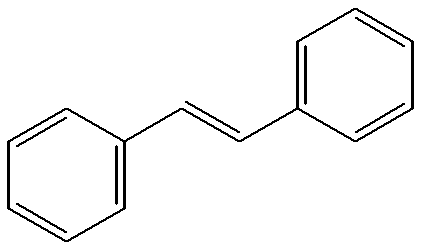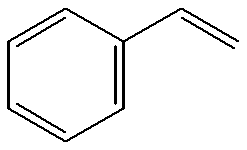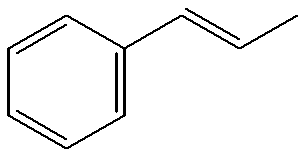Process for preparing MeO-Peg-protected dihydroquinine or dihydroquinidine derivatives, new dihydroquinine or dihydroquinidine derivatives and their use
a technology of dihydroquinidine and dihydroquinidine, which is applied in the field of process for preparing meopeg-protected new dihydroquinidine or dihydroquinidine derivatives and their use, can solve the problems of poor yield, drastically worse ee values, and high inantioselectivity of charged catalysts
- Summary
- Abstract
- Description
- Claims
- Application Information
AI Technical Summary
Problems solved by technology
Method used
Image
Examples
example 1
Dihydroxylation of Sytrene
A mixture of 167 mg (15 .mu.mol) (MeOPEG).sub.2 DPP(DHQD).sub.2, 0.99 g (3 mmol) potassium hexacyanoferrate (III), 0.41 g (3 mmol) potassium carbonate and 3.7 mg (10 .mu.mol) potassium osmate in 10 ml t-butanol / water 1:1 were cooled to 0.degree. C. in an ice bath. To this reaction solution, 104 mg (1 mmol) styrene was dripped in under vigorous stirring. After 4 hours, the reaction mixture is treated with 1 g sodium disulfite at 0.degree. C. with care, and allowed to warm to room temperature. The mixture is diluted with 10 ml methylene chloride and separated from the aqueous phase. The ligand is precipitated from the aqueous phase by the slow dripping in of MTBE with vigorous stirring and recovered in good yield (164 mg, 98%). The dihydroxylated styrene remains in the organic solution and can be isolated by concentration and chromatography on silica gel with MTBE in yields of up to 127 mg (92% of theory) and 98% ee.
B: PREPRATION OF THE LIGAND
example 2
Synthesis from 4-Bromobenzamidene Hydrochloride
To a solution of 0.35 g (15 mmol) of sodium in 150 ml of methanol, there were added 27.30 g (150 mmol) of 4-bromobenzonitrile. Under stirring 48 hours at room temperature 8.0 g (150 mmol) of ammonium chloride were added and stirred for a further 24 hours. The surplus ammonium chloride was filtered off and washed with methanol and methylene chloride (100 ml in each case). After removal of the solvents, there is provided a colorless solid which were subsequently washed with 150 ml diethyl ether. The yield was 11.76 g (50 mmol), 33% theory.
The ether wash solution can be concentrated to yield 16.57 g (91 mmol) of recovered 4-bromobenzonitrile.
.sup.1 H-NMR (300 MGz, DMSO-d.sub.6): .quadrature.3.17 (s, 4H; NH), 7.80-7.92 (m, 4H; Ar--H).
Synthesis of 2-(4-bromophenyl)-5-phenyl-4,6-dihydroxypyrimidine
Into a solution of 3.45 g (150 mmol) of sodium in 100 ml methanol, here were sequentially added 10.98 g (47 mmol) 4-bromobenzamidine hydrochloride ...
example 3
Synthesis of 2.3-bis(4-bromophenyl-5.8-dihydroxypyrazino-[2,3-d]-pyridazine
A solution of 7.11 g (50 mmol) 4,5-diamino-3,6-dihydroxy pyridazine and 20 g (54 mmol) 4,4'-dibromobenzil (sic) (dibromobenzene) in 400 ml of glacial acetic acid were heated for 5 hours at 110.degree. C. (after 10 minutes a yellow precipitate is formed). It was gradually cooled down to room temperature, the precipitate filtered off, and washed twice with 50 ml glacial acetic acid and twice with N-hexane. The yield is 19.03 g (40 mmol, 80% of theory) of a yellow solid. m.p.: >240.degree. C.
Elemental analysis: C.sub.18 H.sub.10 Br.sub.2 N.sub.4 O.sub.2 (474.11 g / mol) Calc. C 45.60, H 2.13, N 11.82; Found: C 45.81, H 2.29, N 11.85
Synthesis of 2,3-bis(4-bromphenyl)-5,8-dichloropyrazino-[2,3-d]-pyridazine
A mixture of 180 g (38 mmol) 2,3-bis(4-bromophenyl)-5,8-diydroxypyrazino-[2,3-d]-pyridazine and 15.81 g (756 mmol) phosphorus pentachloride in 200 ml phosphoryl chloride was heated for 90 minutes at 120.degree. C....
PUM
| Property | Measurement | Unit |
|---|---|---|
| temperatures | aaaaa | aaaaa |
| temperatures | aaaaa | aaaaa |
| temperatures | aaaaa | aaaaa |
Abstract
Description
Claims
Application Information
 Login to View More
Login to View More - R&D
- Intellectual Property
- Life Sciences
- Materials
- Tech Scout
- Unparalleled Data Quality
- Higher Quality Content
- 60% Fewer Hallucinations
Browse by: Latest US Patents, China's latest patents, Technical Efficacy Thesaurus, Application Domain, Technology Topic, Popular Technical Reports.
© 2025 PatSnap. All rights reserved.Legal|Privacy policy|Modern Slavery Act Transparency Statement|Sitemap|About US| Contact US: help@patsnap.com



